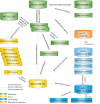IMGT®, the international ImMunoGeneTics information system® 25 years on
- PMID: 25378316
- PMCID: PMC4383898
- DOI: 10.1093/nar/gku1056
IMGT®, the international ImMunoGeneTics information system® 25 years on
Abstract
IMGT(®), the international ImMunoGeneTics information system(®)(http://www.imgt.org) is the global reference in immunogenetics and immunoinformatics. By its creation in 1989 by Marie-Paule Lefranc (Université de Montpellier and CNRS), IMGT(®) marked the advent of immunoinformatics, which emerged at the interface between immunogenetics and bioinformatics. IMGT(®) is specialized in the immunoglobulins (IG) or antibodies, T cell receptors (TR), major histocompatibility (MH) and proteins of the IgSF and MhSF superfamilies. IMGT(®) is built on the IMGT-ONTOLOGY axioms and concepts, which bridged the gap between genes, sequences and 3D structures. The concepts include the IMGT(®) standardized keywords (identification), IMGT(®) standardized labels (description), IMGT(®) standardized nomenclature (classification), IMGT unique numbering and IMGT Colliers de Perles (numerotation). IMGT(®) comprises 7 databases, 17 online tools and 15,000 pages of web resources, and provides a high-quality and integrated system for analysis of the genomic and expressed IG and TR repertoire of the adaptive immune responses, including NGS high-throughput data. Tools and databases are used in basic, veterinary and medical research, in clinical applications (mutation analysis in leukemia and lymphoma) and in antibody engineering and humanization. The IMGT/mAb-DB interface was developed for therapeutic antibodies and fusion proteins for immunological applications (FPIA). IMGT(®) is freely available at http://www.imgt.org.
© The Author(s) 2014. Published by Oxford University Press on behalf of Nucleic Acids Research.
Figures


References
-
- Lefranc M.-P., Lefranc G. The Immunoglobulin FactsBook. London: Academic Press; 2001.
-
- Lefranc M.-P., Lefranc G. The T cell receptor FactsBook. London: Academic Press; 2001.
-
- Lefranc M.-P. Nomenclature of the human immunoglobulin genes. In: Coligan JE, Bierer BE, Margulies DE, Shevach EM, Strober W, editors. Current Protocols in Immunology, A.1P.1-A.1P.37. Hoboken, NJ: John Wiley and Sons; 2000. pp. 1–37. - PubMed
Publication types
MeSH terms
Substances
LinkOut - more resources
Full Text Sources
Other Literature Sources
Miscellaneous

